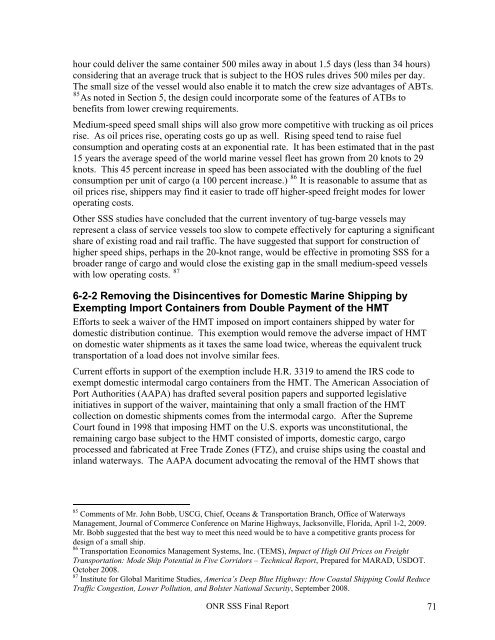Office of Naval Research - National Transportation Library
Office of Naval Research - National Transportation Library
Office of Naval Research - National Transportation Library
You also want an ePaper? Increase the reach of your titles
YUMPU automatically turns print PDFs into web optimized ePapers that Google loves.
hour could deliver the same container 500 miles away in about 1.5 days (less than 34 hours)considering that an average truck that is subject to the HOS rules drives 500 miles per day.The small size <strong>of</strong> the vessel would also enable it to match the crew size advantages <strong>of</strong> ABTs.85 As noted in Section 5, the design could incorporate some <strong>of</strong> the features <strong>of</strong> ATBs tobenefits from lower crewing requirements.Medium-speed speed small ships will also grow more competitive with trucking as oil pricesrise. As oil prices rise, operating costs go up as well. Rising speed tend to raise fuelconsumption and operating costs at an exponential rate. It has been estimated that in the past15 years the average speed <strong>of</strong> the world marine vessel fleet has grown from 20 knots to 29knots. This 45 percent increase in speed has been associated with the doubling <strong>of</strong> the fuelconsumption per unit <strong>of</strong> cargo (a 100 percent increase.) 86 It is reasonable to assume that asoil prices rise, shippers may find it easier to trade <strong>of</strong>f higher-speed freight modes for loweroperating costs.Other SSS studies have concluded that the current inventory <strong>of</strong> tug-barge vessels mayrepresent a class <strong>of</strong> service vessels too slow to compete effectively for capturing a significantshare <strong>of</strong> existing road and rail traffic. The have suggested that support for construction <strong>of</strong>higher speed ships, perhaps in the 20-knot range, would be effective in promoting SSS for abroader range <strong>of</strong> cargo and would close the existing gap in the small medium-speed vesselswith low operating costs. 876-2-2 Removing the Disincentives for Domestic Marine Shipping byExempting Import Containers from Double Payment <strong>of</strong> the HMTEfforts to seek a waiver <strong>of</strong> the HMT imposed on import containers shipped by water fordomestic distribution continue. This exemption would remove the adverse impact <strong>of</strong> HMTon domestic water shipments as it taxes the same load twice, whereas the equivalent trucktransportation <strong>of</strong> a load does not involve similar fees.Current efforts in support <strong>of</strong> the exemption include H.R. 3319 to amend the IRS code toexempt domestic intermodal cargo containers from the HMT. The American Association <strong>of</strong>Port Authorities (AAPA) has drafted several position papers and supported legislativeinitiatives in support <strong>of</strong> the waiver, maintaining that only a small fraction <strong>of</strong> the HMTcollection on domestic shipments comes from the intermodal cargo. After the SupremeCourt found in 1998 that imposing HMT on the U.S. exports was unconstitutional, theremaining cargo base subject to the HMT consisted <strong>of</strong> imports, domestic cargo, cargoprocessed and fabricated at Free Trade Zones (FTZ), and cruise ships using the coastal andinland waterways. The AAPA document advocating the removal <strong>of</strong> the HMT shows that85 Comments <strong>of</strong> Mr. John Bobb, USCG, Chief, Oceans & <strong>Transportation</strong> Branch, <strong>Office</strong> <strong>of</strong> WaterwaysManagement, Journal <strong>of</strong> Commerce Conference on Marine Highways, Jacksonville, Florida, April 1-2, 2009.Mr. Bobb suggested that the best way to meet this need would be to have a competitive grants process fordesign <strong>of</strong> a small ship.86 <strong>Transportation</strong> Economics Management Systems, Inc. (TEMS), Impact <strong>of</strong> High Oil Prices on Freight<strong>Transportation</strong>: Mode Ship Potential in Five Corridors – Technical Report, Prepared for MARAD, USDOT.October 2008.87 Institute for Global Maritime Studies, America’s Deep Blue Highway: How Coastal Shipping Could ReduceTraffic Congestion, Lower Pollution, and Bolster <strong>National</strong> Security, September 2008.ONR SSS Final Report 71
















